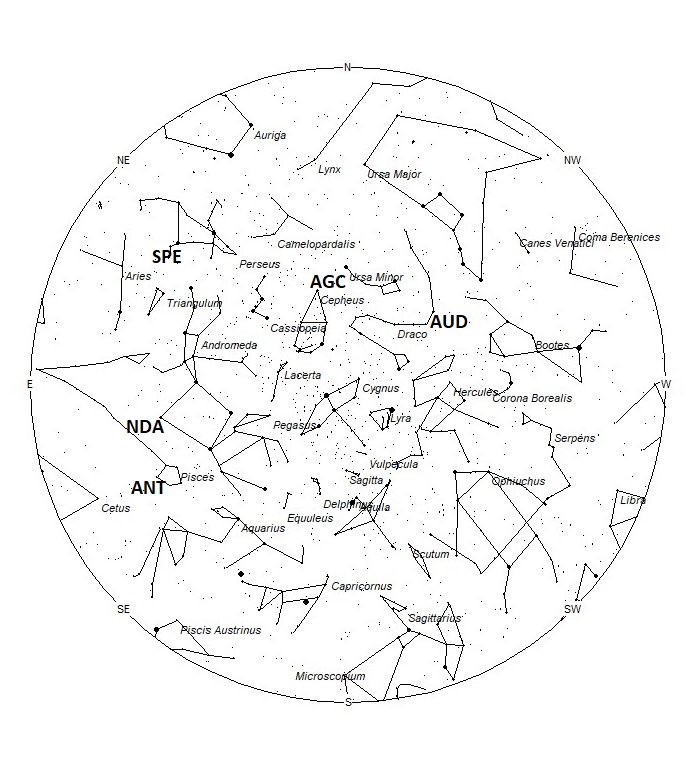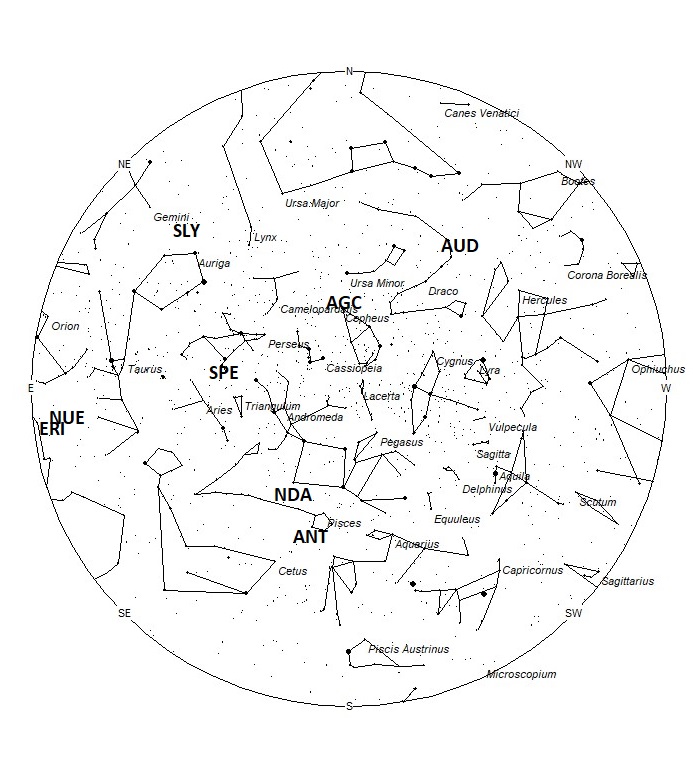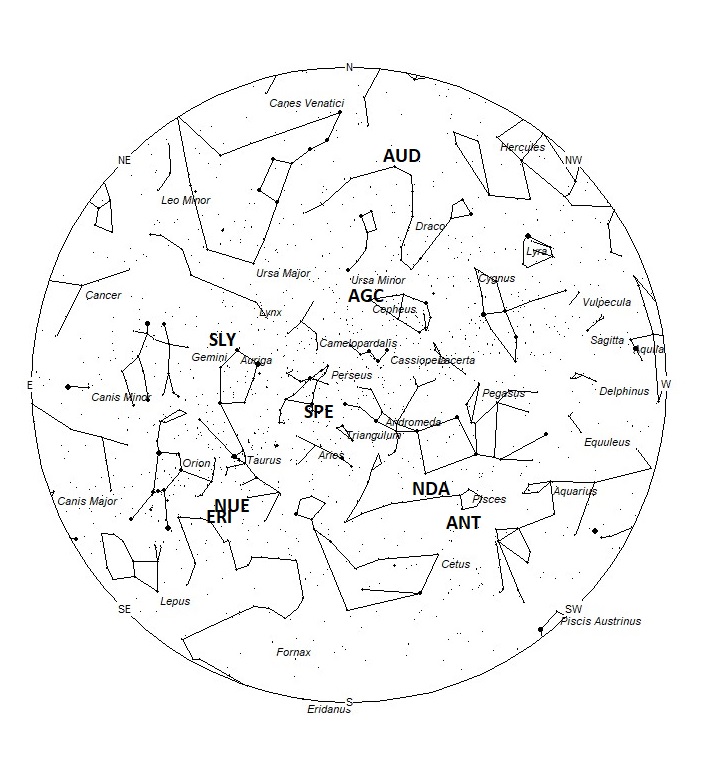During this period, the moon reaches its new phase on Tuesday September 7th. At that time the moon lies near the sun and is invisible at night. This weekend the waning crescent moon will rise shortly before dawn and will not interfere with meteor observing. Late in this period the waxing crescent moon will enter the evening sky but again it will set near the end of dusk and will not interfere with meteor observing. The estimated total hourly meteor rates for evening observers this week is near 4 as seen from mid-northern latitudes (45N) and 3 as seen from tropical southern locations (25S). For morning observers, the estimated total hourly rates should be near 14 as seen from mid-northern latitudes (45N) and 9 as seen from tropical southern locations (25S). The actual rates will also depend on factors such as personal light and motion perception, local weather conditions, alertness, and experience in watching meteor activity. Note that the hourly rates listed below are estimates as viewed from dark sky sites away from urban light sources. Observers viewing from urban areas will see less activity as only the brighter meteors will be visible from such locations.
The radiant (the area of the sky where meteors appear to shoot from) positions and rates listed below are exact for Saturday night/Sunday morning September 4/5. These positions do not change greatly day to day so the listed coordinates may be used during this entire period. Most star atlases (available at science stores and planetariums) will provide maps with grid lines of the celestial coordinates so that you may find out exactly where these positions are located in the sky. I have also included charts of the sky that display the radiant positions for evening, midnight, and morning. The center of each chart is the sky directly overhead at the appropriate hour. These charts are oriented for facing south but can be used for any direction by rotating the charts to the desired direction. A planisphere or computer planetarium program is also useful in showing the sky at any time of night on any date of the year. Activity from each radiant is best seen when it is positioned highest in the sky, either due north or south along the meridian, depending on your latitude. It must be remembered that meteor activity is rarely seen at the radiant position. Rather they shoot outwards from the radiant, so it is best to center your field of view so that the radiant lies at the edge and not the center. Viewing there will allow you to easily trace the path of each meteor back to the radiant (if it is a shower member) or in another direction if it is sporadic. Meteor activity is not seen from radiants that are located far below the horizon. The positions below are listed in a west to east manner in order of right ascension (celestial longitude). The positions listed first are located further west therefore are accessible earlier in the night while those listed further down the list rise later in the night.
These sources of meteoric activity are expected to be active this week.
.
The last of the zeta Draconids (AUD) should be visible this weekend. The radiant is currently located at 15:36 (234) +56, which places it in central Draco, 3 degrees southeast of the 4th magnitude star known as Edasich (iota Draconis). This radiant is best placed near 1800 local summer time (LST), when it lies on the meridian and is located highest in the sky. With an entry velocity of 21 km/sec., the average zeta Draconid meteor would be of slow velocity. Rates this week are expected to be less than 1 no matter your location. Due to the high northern declination these meteors are difficult to observe from the southern hemisphere. These meteors are synomous with the August Draconids (AUD).
The center of the large Anthelion (ANT) radiant is currently located at 23:40 (355) -02. This position lies in western Pisces, 4 degrees south of the 4th magnitude star known as lambda Piscium. Due to the large size of this radiant, Anthelion activity may also appear from northwestern Cetus, northeastern Aquarius, and western Pisces. This radiant is best placed near 0200 LST, when it lies on the meridian and is located highest in the sky. Rates at this time should be near 2 per hour no matter your location. With an entry velocity of 30 km/sec., the average Anthelion meteor would be of slow velocity.
The August gamma Cepheids (AGC) are a recent discovery by Damir Šegon and the Croatian Meteor Network team based on studying SonotaCo and CMN observations (SonotaCo 2007-2011, CMN 2007-2010). Meteors from this source are expected from August 17 through September 6, with maximum activity occurring on August 29. The current position lies at 23:58 (359) +79, which lies in eastern Cepheus, 4 degrees northwest of the 3rd magnitude star known as Errai (gamma Cephei A). This radiant is best placed near 0200 LST, when it lies on the meridian and is located highest in the sky. Rates at this time should be less than 1 per hour as no matter your location. With an entry velocity of 45 km/sec., the average meteor would be of medium velocity. These meteors are not visible south of latitude 10 South.
The last of the August beta Piscids (NDA) should be seen this week. These meteors are part of the Northern delta Aquariid complex, active from August 18-September 8. This second peak of the NDA’s occurred on August 21st, when the radiant lies well within the boundaries of the constellation of Pisces. The radiant currently lies at 00:18 (005) +10, which is located in central Pisces, 5 degrees south of the 3rd magnitude star known as Algenib (gamma Pegasi). This radiant is best placed near 0300 LST, when it lies on the meridian and is located highest in the sky. Hourly rates at this time should be less than 1 no matter your location. With an entry velocity of 37 km/sec., the average meteor from this source would be of medium velocity.
The September epsilon Perseids (SPE) are active from September 2-23, with maximum activity occurring on the 9th. The current position of the radiant lies at 02:52 (043) +39. This area of the sky lies in southwestern Perseus, near the spot occupied by the 4th magnitude star known as 16 Persei. The famous eclipsing binary star known as Algol (beta Persei) lies 4 degrees to the northeast. This radiant is best placed near 0500 LST, when it lies on the meridian and is located highest in the sky. Rates at this time should be near 1 per hour as seen from the Northern Hemisphere and less than 1 as seen from south of the equator. For observers in the Northern Hemisphere, rates should increase to near 3 per hour on September 9th. There have been outbursts from this source in the past, but none are predicted for this year. With an entry velocity of 64 km/sec., the average meteor would be of swift velocity.
The nu Eridanids (NUE) were co-discovered by Japanese observers using SonotoCo and Jürgen Rendtel and Sirko Molau of the IMO. Activity from this source stretches from August 31 to September 21. The main maximum activity occurs on September 10th. A secondary maximum occurs on September 17th. The radiant currently lies at 04:16 (064) -01, which places it in northeastern Eridanus, 7 degrees southeast of the 4th magnitude star known as nu Tauri. Note that this position is close to the radiant of the eta Eridanids. One must face the radiants of these two sources to separate them. This area of the sky is best seen during the last dark hour before dawn when the radiant lies highest in a dark sky. Current rates are expected to be less than 1 per hour during this period no matter your location. With an entry velocity of 65 km/sec., the average meteor from this source would be of swift velocity.
The eta Eridanids (ERI) are active from a radiant near 04:25 (066) -05. This position lies in northeastern Eridanus, near the spot occupied by the dim star known as xi Eridani. This source is active until September 10th, with maximum activity occurring on August 6th. Current rates would be less than 1 per hour no matter your location. These meteors are best seen during the last dark hour prior to dawn when the radiant lies highest above the horizon in a dark sky. With an entry velocity of 64 km/sec., the average meteor from this source would be of swift speed. Note that this position is very close to the radiant of the nu Eridanids. Care must be taken to separate the two sources.
The September Lyncids (SLY) are a complex source of activity active from late August through mid-October. Most of this activity is only recognizable by video means but the main radiant may be followed by visual means. This radiant is active from August 30 through September 20 with maximum occurring on September 10. This radiant is currently located at 06:36 (099) +55. This position is located in extreme northwestern Lynx. The nearest bright star is 4th magnitude delta Aurigae, which lies 5 degrees to the west of the radiant. Current rates would be less than 1 per hour no matter your location. These meteors are best seen during the last dark hour prior to dawn when the radiant lies highest above the horizon in a dark sky. With an entry velocity of 60 km/sec., the average meteor from this source would be of swift speed. Due to the high northern declination (celestial latitude) these meteors are difficult to see from the Southern Hemisphere.
As seen from the mid-northern hemisphere (45N) one would expect to see approximately 11 sporadic meteors per hour during the last hour before dawn as seen from rural observing sites. Evening rates would be near 3 per hour. As seen from the tropical southern latitudes (25S), morning rates would be near 7 per hour as seen from rural observing sites and 2 per hour during the evening hours. Locations between these two extremes would see activity between the listed figures.
|
SHOWER |
DATE OF MAXIMUM ACTIVITY | CELESTIAL POSITION | ENTRY VELOCITY | CULMINATION | HOURLY RATE | CLASS |
| RA (RA in Deg.) DEC | Km/Sec | Local Summer Time | North-South | |||
| zeta Draconids (AUD) | Aug 26 | 15:36 (234) +56 | 221 | 18:00 | <1 – <1 | IV |
| Anthelion (ANT) | – | 23:40 (355) -02 | 30 | 02:00 | 2 – 2 | II |
| August gamma Cepheids (AGC) | Aug 29 | 23:58 (359) +79 | 45 | 02:00 | <1 – <1 | IV |
| August beta Piscids (NDA) | Aug 21 | 00:18 (005) +10 | 37 | 03:00 | <1 – <1 | IV |
| September epsilon Perseids (SPE) | Sep 09 | 02:52 (043) +39 | 64 | 06:00 | 1 – <1 | II |
| nu Eridanids (NUE) | Sep 10 | 04:16 (064) -01 | 65 | 07:00 | <1 – <1 | IV |
| eta Eridanids (ERI) | Aug 06 | 04:25 (066) -05 | 64 | 07:00 | <1 – <1 | II |
| September Lyncids (SLY) | Sep 10 | 06:36 (099) +55 | 60 | 09:00 | <1 – <1 | IV |




